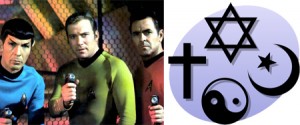 For a while now I’ve been composing an essay on a religion that finds metaphorical inspiration from pop culture, in particular The Matrix trilogy of films, a religion called, appropriately enough, Matrixism. In my exploration of this hyper-real spirituality, I considered a number of interesting research threads, including myth, science fiction narratives as sacred stories, and fan participation at conventions as a form of pilgrimage.
For a while now I’ve been composing an essay on a religion that finds metaphorical inspiration from pop culture, in particular The Matrix trilogy of films, a religion called, appropriately enough, Matrixism. In my exploration of this hyper-real spirituality, I considered a number of interesting research threads, including myth, science fiction narratives as sacred stories, and fan participation at conventions as a form of pilgrimage.
One of the research sources I interacted with was Michael Jindra’s journal article, “Star Trek Fandom as Religious Phenomenon” from the Sociology of Religion, vol. 55, no. 1 (1994): 27-51. While it might seem strange to some to consider Star Trek fandom as an expression of religion, Jindra’s work is in keeping with a growing body of scholarship that notes the increasing tendency of aspects of popular culture to be appropriated by individuals as a point of connection to the sacred. When this is connected to science fiction’s frequent interaction with questions of transcendence, and a focus on religious function in the life of individuals rather than definitions of more traditional religions in the past, the idea that Star Trek fandom might in some instances be religious is not far fetched.
In his conclusion Jindra states in part:
Indeed, I would argue that ST fandom has strong elements of a “civil religion.” Robert Bellah, who popularized the notion of a civil religon, calls it “an understanding of the American experience in light of the ultimate and universal reality” that seeks to become a world civil religion, which is exactly what we seem to have in the assimilationist, homogeneous Earth of twenty-fourth century Star Trek. A civil religion is a “generalizing” of religious belief necessary to have an integrated society, as a counter to “pluralizing” trends that divide society. The generalized beliefs involved in ST fandom consist, as detailed above, in putting faith in science, humanity and a positive future. Much of science fiction in general displays the same beliefs, functioning “rather like a new civil religion, legitimating anthropocentric attitudes and providing compensators for the alien sterility of the physical world,” a primary example being the interesting career of science fiction writers-therapist-religious leader L. Ron Hubbard and his Church of Scientology.
Jindra’s further explorations of this perspective can be found in a more recent essay, along with other interesting contributions and perspectives, in Jennifer E. Porter and Darcee L. McClaren, eds., Star Trek and Sacred Ground: Explorations of Star Trek, Religion and American Culture (State University of New York Press, 2000).





4 Responses to “Star Trek Fandom as a Religious Phenomenon?”